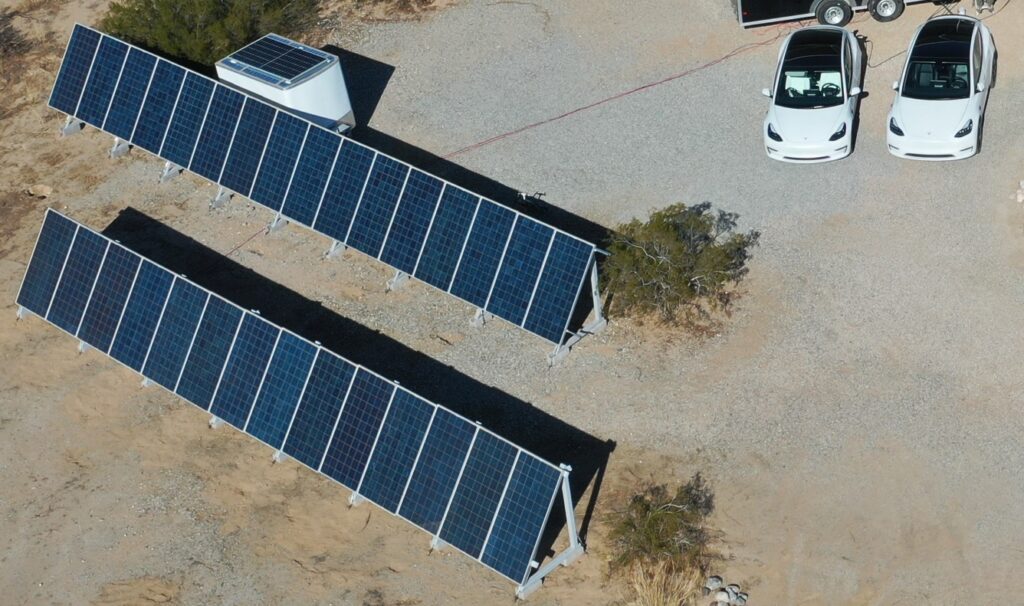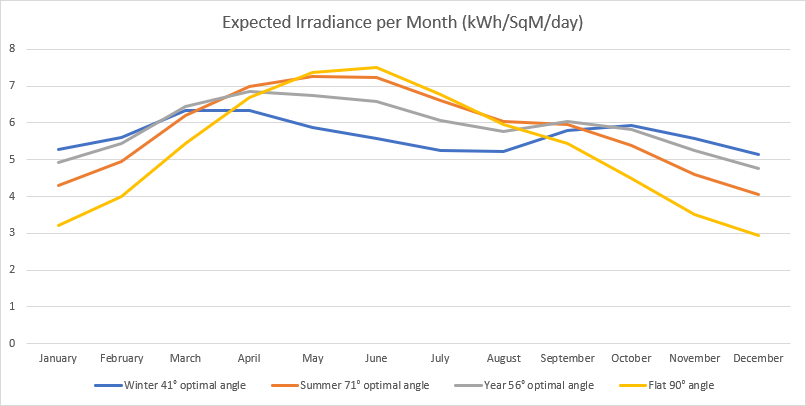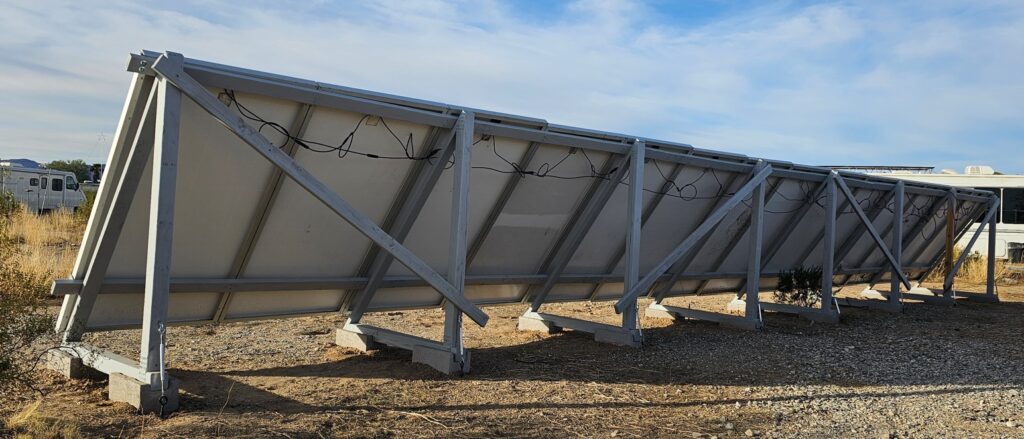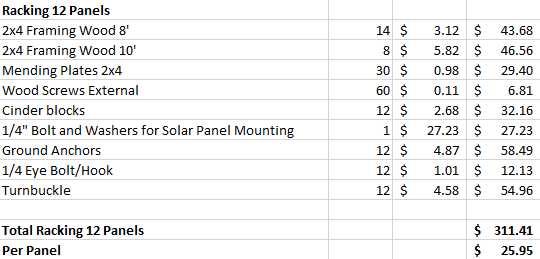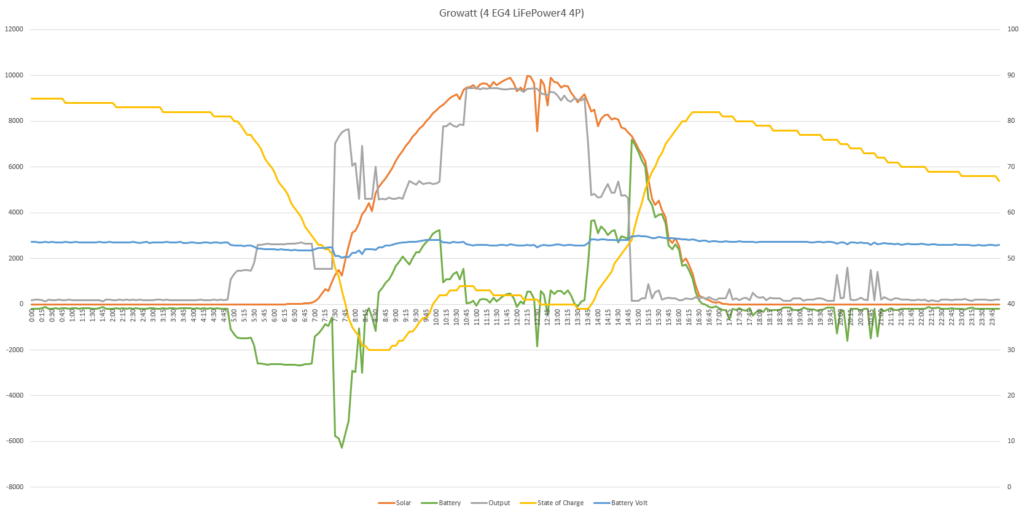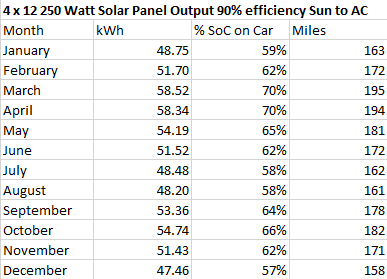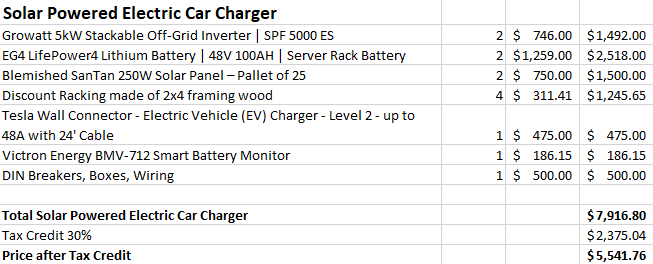I have gained a lot of experience with charging our Tesla from or mobile and ground deployed solar solution. I have been thinking about what the price is to build a low-cost solution, able to charge an electric car from 10% to 90% in a day or two. The first thing is of course a large solar array, but a charger and inverter is needed to make the 240 Volt with the charger working off-grid is a battery needed too.
To charge an electric car is a lot of energy needed. We have a Tesla Model Y Long Range with a battery that is around 80 kWh. The charging efficiency is 85%, so to charge the car from 10% to 90% is 80 kWh * (90%-10%) / 85% = 75.3 kWh. I will use 75 kWh as the required energy for a charge for this estimate. Typical places where you have the space and can build on your own large lot is Borrego Springs, CA or Salome AZ. Both within mayor area on a single charge.
When building a solar array is there many factors to consider, first of all if you are allowed to. So, I assume that you have large flat lot with plenty of space and is making a solar array on the ground of basic materials with hand-tools. If you add to existing structures is the permitting a long and potentially costly process.
The most important part to generate maximum energy is what direction the solar panels face and the angle. To make an optimal setup is facing directly south preferred, but the optimal angle depends on the time of year. There is a very useful web-site Solar Electricity Handbook with a calculator for location and direction.
Over a year is there a lot of variation depending on the angle of the solar panels. But charging an electric car is maybe also different over the months. In the summer is a lot more energy needed for air condition when driving, this could match using the lower angle. Another option is simply to throw the panels flat on the ground with no racking required but that hurt the winter output a lot.
The average monthly irradiance per area can be used to calculate the required amount of solar panels. I will be using a winter optimized setup that never receive under 5 kWh/SqM/Day from panels mounted at 41 degrees from vertical.
The next thing to consider is what solar panels to use. New panels has a high efficiency around 20%, but older panels are very cheap per watt. I will assume using recycled solar panels with and efficiency of 12%. This efficiency is what you can expect from a 10-year-old solar panel that can be bought from Santan Solar. A typical 60 cell solar panels is 1.6 square meter so it can generate 5 kWh/SqM/Day * 1.6 SqM * 12 % = 0.96 kWh/Day. To charge the electric car with a 75-kWh battery in 1 day is 1 Day * 75 kWh / 0.96 kWh = 78 Solar Panels, 2 days is of course half that with 39 solar panels. A pallet of 25 used 250-Watt solar panels is available from Santan Solar for $750 or $30 per panel. I use 2 pallets of those for my example.
The next thing to consider is the need for mounting of the solar panels. The optimal winter angle is 41 degrees so just leaning the panels against a shed can be an option, but we have seen a lot of wind damage to solar panels even lying flat on the ground from storms and especially Dust Devils that can pick up solar panels and throw them around. A frame built of 2x4 mounted on cinder blocks to avoid termites is a cheap solution. To mount the panels should screws be avoided. the heat and dryness are loosening the screws very fast. using 1/4-inch bolts and washers has been working well with our rack.
Using ground anchors that is screwed into the dirt and a turnbuckle allows for a lot of future adjustments. An array like this for 12 solar panels can be built for $312. Making the cost per solar panel $26. At this point can it be considered getting almost twice the number of solar panels instead, but throwing panels on the ground directly is not a long-term solution. Dirt is accumulating on the panels quickly and the environment is also very wet with water accumulating on the backside of the solar panels.
This is a list of the needed components and cost breakdown for the rack mount.
The next is to get the solar energy to something that can be used for charging the electric car. 240 Volt AC is the way to move most energy at home. A Tesla Model Y can accept 48 Amperes at 240 Volt, this is 11.5 kW. To generate that amount of AC power is multiple inverters needed and batteries too for an off-grid solution. These parts are the expensive ones and to limit the cost is the charging in this example going to be limited to 40 Ampere or 9.6 kW. This allow using two Growatt 5000-Watt inverter/chargers and two EG4 LifePower4 5.1 kWh batteries. The low amount of storage with only 10.2 kWh (80% useful) of course only allows very limited charging without the sun creating power.
This is a winter day where we with manual control follow the power created from the sun while charging the car. This is from our array of 8.5 kW angled panels and 7 kW of flat mounted panels with a 20.5 kWh battery bank. With a smaller battery bank is better control needed and some EV chargers allow to be controlled with an On/Off signal like the relay from the Victron battery monitor alternatively can the power to the charger just be cut with a controlled relay. The power generated in average by month also allow over 150 miles of driving after a day of charging.
We now have all the components needed. One thing that is available is the solar tax credit of 30%. This apply to all components of a solar system even if it is not grid tied.
With a cost of $5600 (after Tax Credit) can this seems like a lot, but looking at just the charging cost is the payback time very good from a little over 2 year to 6 years depending on the location. Without a home charger or with California power prices is a system like this very good and if you drive more than 12000 miles (locally) per year even shorter payback.
This system of course makes a lot of assumptions like free land to build a rack mount and having the car home during the day to charge when the sun is shining. The system is capable of generating over 17,000 kWh per year and the car only need 33% (5540 kWh) so a lot more can be done with this Solar Charging setup.
The 240 Volt system can also be used to run a 240 Volt mini-split air conditioner or an electric water heater. The electric water heater is a good way to store extra energy (heat battery), with a large well insulated tank can the electric water heater run during the day when access energy is available and be turned off at night and still have enough hot water. If all the excess energy 17,000 kWh - 5540 kWh = 11,460 kWh can 59000 gallon of water be heated or more than 160 gallon a day.
With a Split-Phase transformer ($299) can the system also make 120 Volt for smaller loads. But connecting this to a run a whole house need more batteries to last overnight and more careful management of the State of Charge end of the day.
